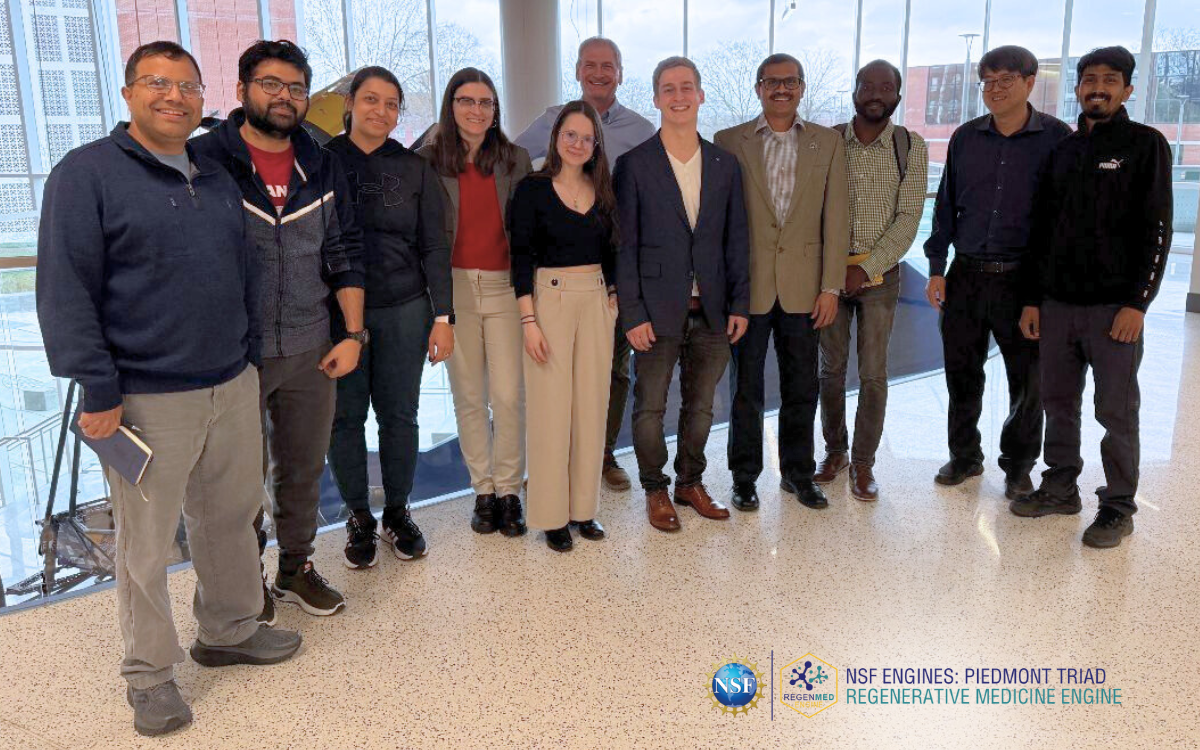From Austria to NC: GeisterBio to build bioprinter in PTRME ecosystem
Noah Geister said he was like a kid in a candy shop.
That’s how the 23-year-old founder and CEO of GeisterBio, an Austrian startup developing a groundbreaking bioprinter, described his visit to the Piedmont Triad Regenerative Medicine Engine’s ecosystem.
Noah and Lisa Wesely, his partner and GeisterBio team member, came to the ecosystem for three days in late March to discuss the potential of building and testing GeisterBio’s technology here.
Not only did GeisterBio find PTRME’s hospitality but the equipment, resources and expertise it needs to launch and scale.
“There’s nowhere else in the world I’d build my product and start my company,” Noah said.
PTRME sat down with Noah before his return to Austria to learn about GeisterBio’s innovative bioprinter, how PTRME will benefit his startup and plans to return to our ecosystem.

[This interview has been edited for clarity and brevity].
Q&A with Noah Geister, founder and CEO of GeisterBio
After completing your thesis on 3D bioprinting, you started GeisterBio a few months ago to solve the problems you encountered with this technology. Tell me how GeisterBio’s bioprinter will be different than the ones currently available.
The current state-of-the-art bioprinter has six extruders, meaning it can handle six different bio-inks at the same time. And the switch time between those bio-inks is a couple of seconds at best and the volume is 6,200 milliliters at max. That’s definitely not enough to print an organ. A kidney, for example, needs 16 to 26 different cell types (bio-inks) and needs liters of volume, not milliliters.
Our platform has 32 extruders and can print 3.2 liters of volume with a switch time of less than a second from needle to needle. Every extruder is separate, meaning there’s no flushing needed in between and no contamination. We also use the CLASS (constructs laid in agarose slurry suspension) method. It’s pretty new, but it’s a giant step up from the FRESH (freeform reversible embedding of suspended hydrogels) method. The CLASS method blew the FRESH method out of the water when I tried it – not one single print has failed.
We’re also developing a full stack with software, 3D modeling, firmware, mechanic and biologics for our platform.
How did GeisterBio get connected with PTRME’s ecosystem here in North Carolina all the way from Austria?
My co-founder and COO Paul Wirbelauer sent out emails to about 20 different companies worldwide that we thought might fit our needs. I think five or 10 responded and we met with three. With the first two companies, we knew after 10 minutes that it wasn’t a fit. But then we met with Joshua Hunsberger, PTRME’s chief partnership and stakeholder engagement officer. Within 30 minutes, he connected us with five other people in the ecosystem, including Karen Barnes, PTRME’s ecosystem development officer. Everything sounded so amazing, but we knew that before we establish a company here or anything big like that, we wanted to visit in person, meet people and see the laboratories.
And so how has your visit been? What have you been up to?
I’ve been blown out of the water. The last three days we toured about 10 labs as well as Innovation Quarter. We also went to North Carolina A&T State University twice. It’s so amazing. Every piece of equipment that we’re going to need is here for testing. It’s really cool what Dr. Salil Desai’s team is working on. We’re going to collaborate and they’re going to help us build the printer. It’s not official yet, but there are a lot of cool things that we could do together as complementary technologies.
Day in the life of a visit to PTRME’s ecosystem
9 a.m. - 10 a.m.
Breakfast meeting with PTRME leadership at Krankie’s
10 a.m. - 12 p.m.
Tour PTRME’s Test Bed at WFIRM
12 p.m. - 1 p.m.
Lunch at Alma Mexicana
2 p.m. - 4 p.m.
Meet with Salil Desai, leader of PTRME’s bioprinting ITEC at N.C. A&T, and his team to tour their campus.
7 p.m.
Dinner at Fourth Street Filling Station
I know this is your first time in the United States. Anything memorable from your experience outside of meetings and labs?
I’d have to say the bacon-wrapped scallops with fire-roasted corn from Fourth Street Filling Station. Lisa and I have eaten there pretty much every day. And the Founders’ Restaurant at the Shaffner Inn has amazing breakfast. We also learned about the history of the Reynolds family when Karen gave us a tour of the Reynolda House and Museum and Wake Forest University.
What are your plans to return to PTRME’s ecosystem and work with our partners?
Our plan is to come back in the summer. We’ll build the printer here, because N.C. A&T and the Test Bed have the capability for us to do that, and we’ll start validating it. We have a lot of different tests for repeatability, precision, resolution, and vibration analysis. We’re also thinking of doing a couple of collaborations but I’m not going to say too much now. Until then, we’re going to keep moving forward and decide which tissues we want to print first.
Why is PTRME’s ecosystem the best place for GeisterBio?
There’s so many experts. I think we talked to almost 35 different experts in our time here. The people are so down to earth that you don’t notice if it’s a CEO or just a person next door. That’s the biggest thing that shocked me. I’ve heard the term Southern hospitality a couple times, but it’s been nothing like what I could’ve imagined.
We’re really excited to get started here, too, because in Austria, it’s not that easy to get equipment and lab space. Here it was like bam, bam, bam. It’s a completely different pace and that’s what’s needed for startups. And there’s room to grow, so we don’t have to worry about that. We can just focus on research and grow GeisterBio naturally.
